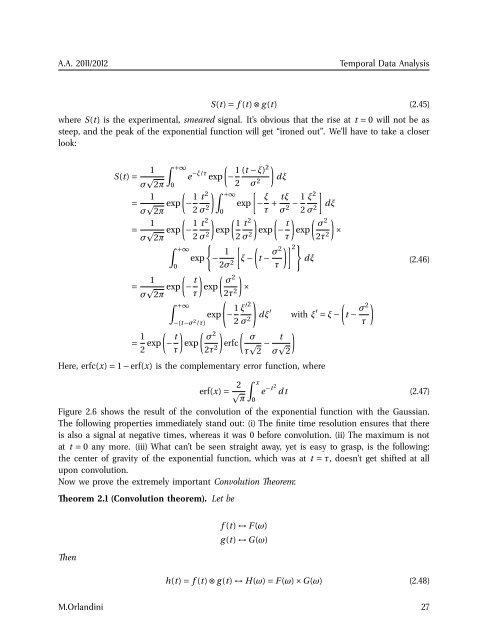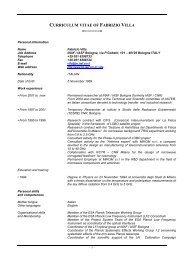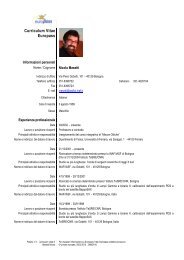booklet format - inaf iasf bologna
booklet format - inaf iasf bologna
booklet format - inaf iasf bologna
You also want an ePaper? Increase the reach of your titles
YUMPU automatically turns print PDFs into web optimized ePapers that Google loves.
A.A. 2011/2012<br />
Temporal Data Analysis<br />
S(t) = f (t) ⊗ g (t) (2.45)<br />
where S(t) is the experimental, smeared signal. It’s obvious that the rise at t = 0 will not be as<br />
steep, and the peak of the exponential function will get “ironed out”. We’ll have to take a closer<br />
look:<br />
S(t) = 1<br />
σ 2π<br />
= 1<br />
∫ +∞<br />
0<br />
(<br />
e −ξ/τ exp − 1 (t − ξ) 2 )<br />
2 σ 2 dξ<br />
t 2 )∫ +∞<br />
[<br />
σ 2 exp − ξ τ + tξ<br />
(−<br />
σ 2π exp 1 2 0<br />
σ 2 − 1 ξ 2 ]<br />
2 σ 2 dξ<br />
= 1 (−<br />
σ 2π exp 1 t 2 ) ( 1 t 2 ) (<br />
2 σ 2 exp<br />
2 σ 2 exp − t ) ( σ<br />
2<br />
)<br />
exp<br />
τ 2τ 2 ×<br />
∫ {<br />
+∞<br />
exp − 1 [ )] 2<br />
}<br />
0<br />
2σ 2 ξ −<br />
(t − σ2<br />
dξ<br />
τ<br />
= 1 (−<br />
σ 2π exp t ) ( σ<br />
2<br />
)<br />
exp<br />
τ 2τ 2 ×<br />
∫ ( )<br />
+∞<br />
exp − 1 ξ ′ 2<br />
)<br />
−(t−σ 2 /τ) 2 σ 2 dξ ′ with ξ ′ = ξ −<br />
(t − σ2<br />
τ<br />
= 1 (<br />
2 exp − t ) ( σ<br />
2<br />
) ( σ<br />
exp erfc<br />
τ 2τ 2 τ 2 − t )<br />
σ 2<br />
Here, erfc(x) = 1 −erf(x) is the complementary error function, where<br />
(2.46)<br />
erf(x) = 2 ∫ x<br />
e −t 2 dt (2.47)<br />
π<br />
Figure 2.6 shows the result of the convolution of the exponential function with the Gaussian.<br />
The following properties immediately stand out: (i) The finite time resolution ensures that there<br />
is also a signal at negative times, whereas it was 0 before convolution. (ii) The maximum is not<br />
at t = 0 any more. (iii) What can’t be seen straight away, yet is easy to grasp, is the following:<br />
the center of gravity of the exponential function, which was at t = τ, doesn’t get shifted at all<br />
upon convolution.<br />
Now we prove the extremely important Convolution Theorem:<br />
Theorem 2.1 (Convolution theorem). Let be<br />
0<br />
Then<br />
f (t) ↔ F (ω)<br />
g (t) ↔ G(ω)<br />
h(t) = f (t) ⊗ g (t) ↔ H(ω) = F (ω) ×G(ω) (2.48)<br />
M.Orlandini 27

















